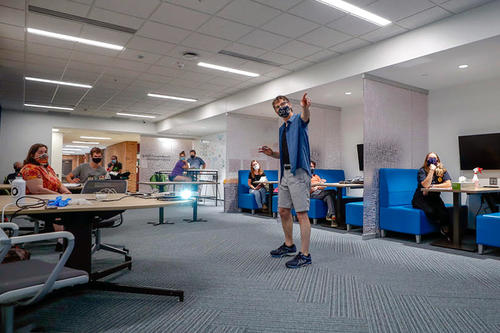
New studies from the U of M College of Science and Engineering analyze how the coronavirus spreads indoors and in human lungs. This information may help businesses and schools control the spread of COVID-19, and help target medicines to virus particles in the lungs.
Using aerosol generation by healthy individuals to mimic that from asymptomatic COVID-19 patients, mechanical engineering associate professor Jiarong Hong and assistant professor Suo Yang modeled virus transmission through aerosols ejected from an infected person via exhalation or speech. They found that the SARS CoV-2 virus hitches a ride on those aerosols and may land on nearby surfaces or be inhaled by another person.
The researchers numerically modeled how the simulated airborne virus flowed through an elevator, a classroom, and a supermarket and compared how the virus fared with different levels of ventilation and different spacing of room occupants.
They found that good indoor ventilation filters out some virus but may leave more viral particles on surfaces. In a classroom where an asymptomatic “teacher” talked for 50 minutes, only 10 percent of the aerosols were filtered out; the majority stuck to the walls.
“The ventilation forms several circulation zones called vortexes, and the aerosols keep rotating in [them],” Yang says. “Because they are basically trapped, it’s very hard for them to reach the vent and actually go out.”
The virus-bearing aerosols spread significantly less when the “teacher” stayed directly under an air vent. This insight could inform how classrooms are arranged and disinfected, and also help places like theaters and concert venues reopen with the proper precautions.
Reaching out
Yang and Hong have been working with the Minnesota Orchestra to measure aerosol concentrations and flow while instruments are played onstage at Orchestra Hall. Eventually, they hope to provide a plan to minimize the COVID-19 risk in Orchestra Hall.
The researchers recently joined an international work group of experts led by U of M professor Michael Osterholm, director of the Center for Infectious Disease Research and Policy, to learn how much SARS CoV-2 virus it takes to become infected and provide science-driven policy to mitigate the COVID-19 pandemic.
Reaching in
Yang is also modeling aerosols to predict how the coronavirus travels inside the human respiratory system.
“The key symptom of COVID-19 is the lung inflammation,” he explains. “We’re trying to understand how the virus aerosol is transported and deposited in the lung. Where is the high concentration zone? What’s the pattern? Does it depend on other conditions?”
By creating models of human lungs based on computed tomography (CT) scans from real COVID-19 patients, Yang hopes to inform the design of medical treatments, namely nasal sprays. His team has already begun running test simulations of aerosols in the back of the throat, nasal linings and trachea.
Then, Yang plans to map how medicine particles travel throughout those same systems in order to test the effectiveness of treatments and get the delivered to the right “address” in the lungs.
“Once we optimize these options, we can give that information to the medicine companies, and they can create their products accordingly to most efficiently target the system," he added
Yang works with biomedical engineering professor David Odde, who earlier this year released a model of how the virus functions within human cells. The two will combine their results into a comprehensive recommendation on treatment design.





